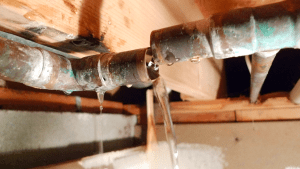Guide To Water Leakage Discovery In The House
Guide To Water Leakage Discovery In The House
Blog Article
We have uncovered this post pertaining to Detecting hidden plumbing leaks listed below on the web and decided it made sense to talk about it with you on this page.

Early detection of leaking water lines can alleviate a possible calamity. Some little water leaks might not be visible.
1. Take A Look At the Water Meter
Examining it is a proven method that assists you discover leaks. If it relocates, that shows a fast-moving leakage. This implies you might have a slow-moving leakage that can also be below ground.
2. Examine Water Intake
If you identify unexpected changes, regardless of your intake being the very same, it implies that you have leaks in your plumbing system. A sudden spike in your costs suggests a fast-moving leakage.
Meanwhile, a consistent rise monthly, even with the very same habits, reveals you have a slow-moving leak that's likewise gradually intensifying. Call a plumber to completely inspect your home, especially if you feel a cozy location on your flooring with piping below.
3. Do a Food Coloring Examination
When it comes to water consumption, 30% comes from bathrooms. If the shade somehow infiltrates your dish throughout that time without flushing, there's a leak between the tank as well as dish.
4. Asses Exterior Lines
Don't neglect to inspect your exterior water lines as well. Test faucets by attaching a garden hose. Ought to water leak out of the link, you have a loosened rubber gasket. Change this as well as guarantee all connections are limited. It will help get it expertly examined and also preserved every year if you've obtained a lawn sprinkler system. One small leakage can waste tons of water and spike your water bill.
5. Examine and also Evaluate the Situation
House owners ought to make it a practice to examine under the sink counters as well as also inside cupboards for any kind of bad odor or mold and mildew development. These 2 warnings indicate a leak so punctual interest is needed. Doing routine evaluations, even bi-annually, can conserve you from a major problem.
If you know your house is currently old, maintain a careful eye on your heating systems, hoses, pipes etc. Check for discolorations and compromising as many home appliances and pipes have a life span. They will certainly additionally naturally deteriorate as a result of damage. Don't wait for it to escalate if you believe leaking water lines in your plumbing system. Call a professional plumber right now so you don't wind up with a terrible mess in your house.
Early detection of dripping water lines can reduce a prospective disaster. Some tiny water leakages might not be visible. Examining it is a guaranteed means that helps you find leakages. One tiny leak can throw away tons of water and surge your water expense.
If you believe dripping water lines in your plumbing system, don't wait for it to rise.
WARNING SIGNS OF WATER LEAKAGE BEHIND THE WALL
PERSISTENT MUSTY ODORS
As water slowly drips from a leaky pipe inside the wall, flooring and sheetrock stay damp and develop an odor similar to wet cardboard. It generates a musty smell that can help you find hidden leaks.
MOLD IN UNUSUAL AREAS
Mold usually grows in wet areas like kitchens, baths and laundry rooms. If you spot the stuff on walls or baseboards in other rooms of the house, it’s a good indicator of undetected water leaks.
STAINS THAT GROW
When mold thrives around a leaky pipe, it sometimes takes hold on the inside surface of the affected wall. A growing stain on otherwise clean sheetrock is often your sign of a hidden plumbing problem.
PEELING OR BUBBLING WALLPAPER / PAINT
This clue is easy to miss in rooms that don’t get much use. When you see wallpaper separating along seams or paint bubbling or flaking off the wall, blame sheetrock that stays wet because of an undetected leak.
BUCKLED CEILINGS AND STAINED FLOORS
If ceilings or floors in bathrooms, kitchens or laundry areas develop structural problems, don’t rule out constant damp inside the walls. Wet sheetrock can affect adjacent framing, flooring and ceilings.
https://www.servicemasterbyzaba.com/blog/how-to-detect-water-leakage-in-walls/

As a passionate reader about Leaking water lines, I was thinking sharing that information was a good idea. In case you appreciated our blog entry please don't forget to pass it around. Thank-you for taking the time to read it.
Report this page